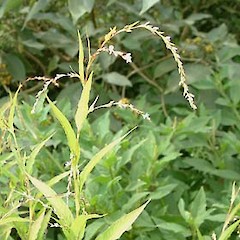Persicaria hydropiper
Common name
water pepper
Synonyms
Polygonum hydropiper
Family
Polygonaceae
Flora category
Vascular – Exotic
Structural class
Herbs - Dicotyledons other than Composites
NVS code
The National Vegetation Survey (NVS) Databank is a physical archive and electronic databank containing records of over 94,000 vegetation survey plots - including data from over 19,000 permanent plots. NVS maintains a standard set of species code abbreviations that correspond to standard scientific plant names from the Ngä Tipu o Aotearoa - New Zealand Plants database.
POLHYD
Conservation status
Not applicable
Brief description
Erect annual herb up to ca 75cm tall, with reddish stems, willow-shaped leaves and long slender flower spikes with small white (greenish flowers).
Distribution
Abundant in lowland regions of the North and South Islands.
Habitat
Occurs on the edge of river banks and marshy areas, also occurring as a submerged plant in clear moderate flowing streams. Not usually grazed by livestock, especially cattle.
Wetland plant indicator status rating
Information derived from the revised national wetland plant list prepared to assist councils in delineating and monitoring wetlands (Clarkson et al., 2021 Manaaki Whenua – Landcare Research Contract Report LC3975 for Hawke’s Bay Regional Council). The national plant list categorises plants by the extent to which they are found in wetlands and not ‘drylands’. The indicator status ratings are OBL (obligate wetland), FACW (facultative wetland), FAC (facultative), FACU (facultative upland), and UPL (obligate upland). If you have suggestions for the Wetland Indicator Status Rating, please contact: [Enable JavaScript to view protected content]
FACW: Facultative Wetland
Usually is a hydrophyte but occasionally found in uplands (non-wetlands).
Detailed description
The leaves are bright green, without markings, they are narrrow and lance shaped with a wavy edge, and up to 12 cm long. There is a membranous sheath (ochrea) at the base of each leaf, that is fringed with short hairs. The inflorescence is slender and drooping, the small flowers occur on short stalks , they are pink or cream (rarely white to greenish white). The fruit is a dull, pitted, dark brown nut. The plant is burning (peppery) to taste
Similar taxa
Distinguished from Persicaria decipiens when flowering by the yellow glands on the tepals of Persicaria hydropiper. The flower heads of P. decipiens are usually erect, and the leaves are dark green/red and often have dark blotches on them; it also lacks the peppery flavour of P. hydropiper
Flowering
November-June
Flower colours
Cream, Green
Fruiting
Autumn
Life cycle
Spreads by seed dispersed by water or waterfowl.
Year naturalised
1906
Origin
Temperate Eurasia, North Africa
Reason for introduction
Unknown, possibly a seed contaminant
Control techniques
Not controlled in New Zealand.
Etymology
persicaria: Medieval name referring to the likeness of the leaves to a peach tree
Attribution
Factsheet prepared by Paul Champion and Deborah Hofstra (NIWA).
References and further reading
Johnson PN, Brooke PA (1989). Wetland plants in New Zealand. DSIR Field Guide, DSIR Publishing, Wellington. 319pp.
Popay et al (2010). An illustrated guide to common weeds of New Zealand, third edition. NZ Plant Protection Society Inc, 416pp.
Coffey BT, Clayton JS (1988). New Zealand water plants: a guide to plants found in New Zealand freshwaters. Ruakura Agricultural Cente. 65pp.






